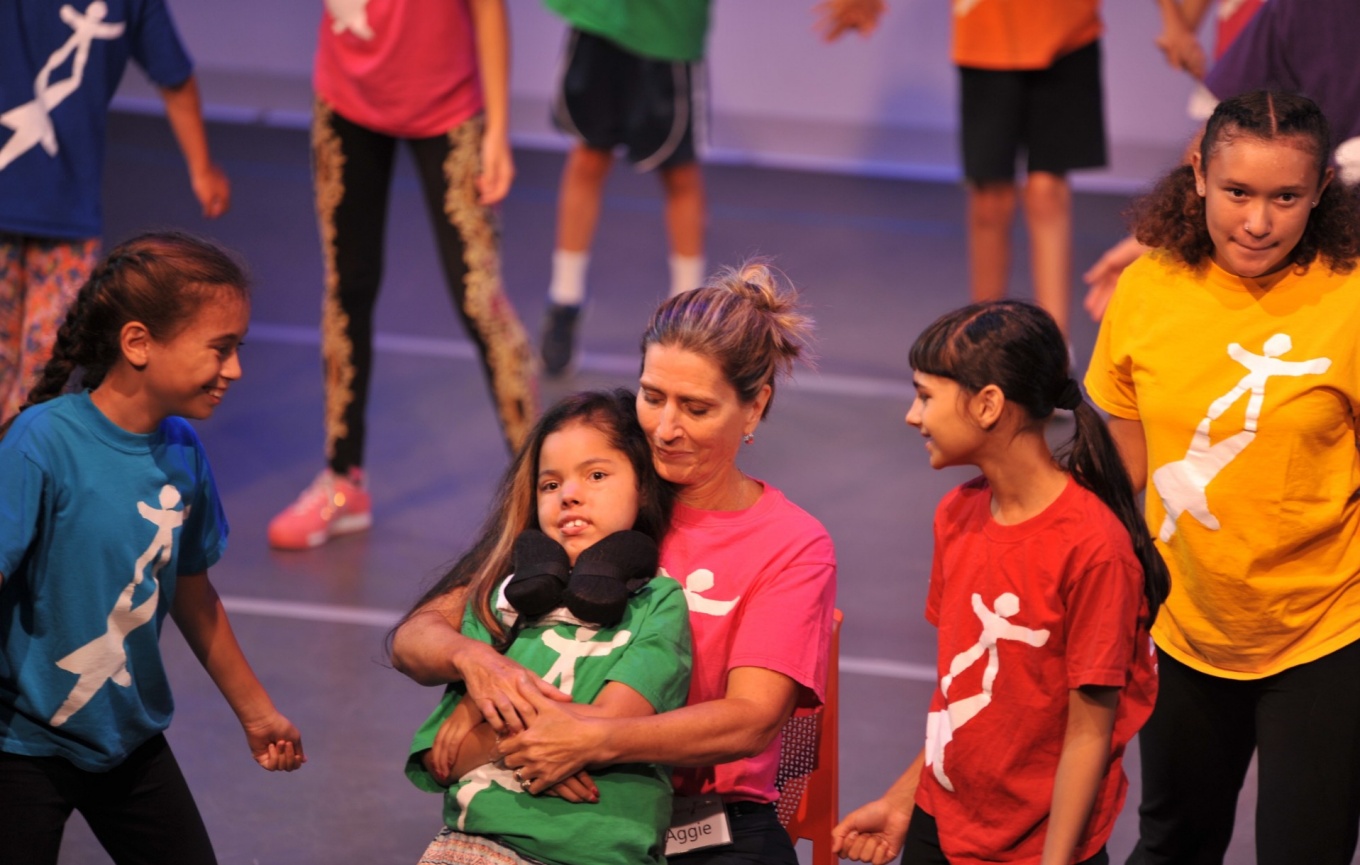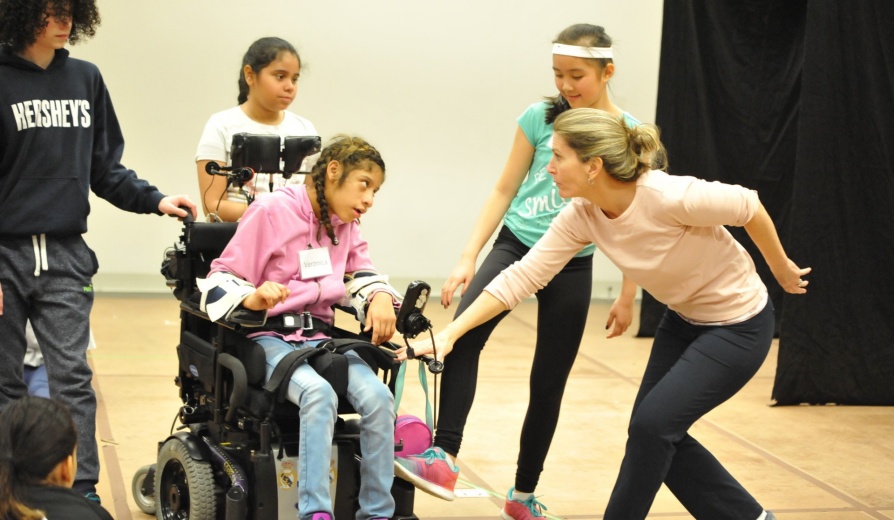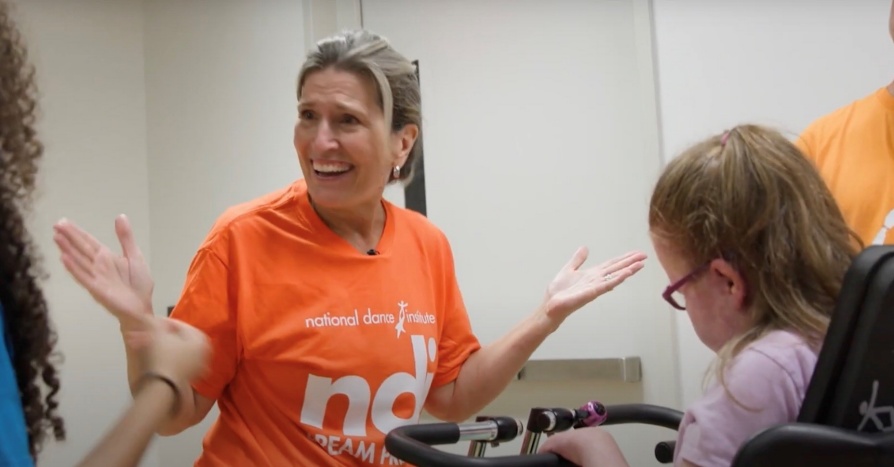
Agnes McConlogue Ferro working with students at the National Dance Institute.
Published February 4, 2025
BY DANIELLE LEGARE
A stage for all: UB alumna’s vision realized with DREAM Project
Agnes McConlogue Ferro, a board-certified specialist in pediatric physical therapy and University at Buffalo Graduate School of Education alumna, turned a lifelong passion for dance into a groundbreaking movement in 2014 when she co-founded the DREAM Project (Dancers Realize Excellence through Arts and Movement) in Harlem, New York.
What began as a vision to make dance truly inclusive has blossomed into an innovative program that is redefining possibilities and transforming the lives of children with and without disabilities.
Now, over ten years after it was first established, DREAM—a collaboration with the National Dance Institute (NDI)—has brought dance into the lives of hundreds of children, many of whom may have otherwise never experienced dance at all.
But DREAM’s origins go back even further. Ferro first began working with NDI in 1998, launching an in-school program in New York City that laid the foundation for DREAM’s inclusive approach.
Grounded in the belief that dance is for everyone, DREAM provides free, biannual weeklong workshops at NDI’s fully accessible center in Harlem. Each workshop culminates in a vibrant group performance where children with disabilities partner with age-matched peers from NDI’s Advanced Teams. Together, they choreograph routines that celebrate collaboration, creativity and the unique abilities of every participant.
A welcoming, strengths-based approach
According to Ferro, who is also a clinical associate professor in Stony Brook University’s physical therapy program, DREAM’s commitment to inclusion is unwavering. “We have never turned away a child,” she said. “If they want to be there, if the parent is willing to bring them there—which can be a tough experience for many families—they’re able to participate.”
Children with varying abilities have participated in the program since it began. Dancers have included children on ventilator support or with minimal mobility. And yet, these children are still fully engaged in the program. They are not treated as passive participants or props but as active partners in the dance experience.

This approach embraces everyone’s strengths, fostering a supportive and empowering environment for all involved.
For Ferro, one of the most moving moments came when a 10-year-old participant who had limited movement, became the driving force behind a new and unique routine. Using her power wheelchair, she pulled the other children behind her, leading the group as the conductor of the dance.
The choreography was entirely inspired by the children, a core tenet of DREAM’s approach. “Anything that we have to do, we just translate. The choreography is sourced from the children,” Ferro said.
This philosophy of adaptation and creativity is embedded in DREAM’s foundation, which was built upon collaboration with co-founders Kay Gayner, NDI's artistic director, and Aileen Barry, NDI's senior director of education and outreach. Their leadership at NDI supports DREAM’s inclusive curriculum, which ensures that every child—regardless of ability—has the opportunity to express themselves through dance.
The power of dance
The benefits of DREAM often extend beyond the dance floor and have a profound impact on children’s lives.
“DREAM’s success is a testament to the vision of NDI’s founder, Jacques d’Amboise,” said Ferro. “He believed in the transformative power of the arts, and that belief continues to shape everything we do.”
A standout memory for Ferro: When a young child with autism enrolled in the program, Ferro and the DREAM team met with her family beforehand to discuss her strengths and goals. The family expressed that their main hope was simply for her to enter the room.
Ferro embraced this as a starting point, working gradually to support the child’s participation. Initially, the child engaged only in small ways. But, by her third DREAM experience, she performed in the entire show.
“This is her happy place. When I think about the most impactful things, it’s meeting children where they are,” Ferro said. “That’s where the magic is.”

A UB journey
Ferro began collecting data about the DREAM Project shortly after establishing it to measure its impact. In time, she realized she wanted to deepen her analysis of the data—and this goal ultimately led her to pursue the curriculum, instruction and the science of learning PhD program at UB.
“I don’t think anything prepared me for not only the level of rigor but also the level of incredible faculty who are part of that program, including Erin Kearney and Tiffany Karalis-Noel,” she said.
“The gift of a lifetime was getting Beth Etopio as my advisor,” Ferro continued. “I don’t know how those stars aligned, but I’m eternally grateful for that because she is a gifted, gifted supporter and instructor.”
Continuing excellence in dance education
Armed with research insights from her doctoral studies, Ferro is committed to growing the program with the hope of bringing it to children throughout the country. She and her colleagues recently conducted training sessions in New Mexico and New Hampshire, where the DREAM curriculum and pedagogy were introduced to new communities.
“We need to do more. The experience that we have at DREAM in Harlem shouldn’t be isolated to just that. It should be expanded as much as we can, as far as we can,” said Ferro. “That’s my goal for the next 50 years.”
DREAM’s next workshop will be held in Harlem from Feb. 18–21, 2025.
Tuesday News Briefs feature the stories of the Graduate School of Education faculty, students and alumni who are engaged in their communities and making an impact through their hard work, dedication and research initiatives. If you have a story to share, please email us with the details for consideration as a future news feature.